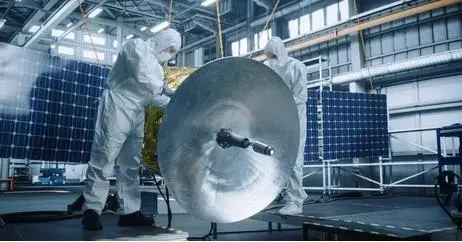The intersection between space exploration and manufacturing is growing stronger, leading to important advancements in both fields. As space missions become more challenging, the need for new manufacturing solutions increases. This drives the development of better materials, improved processes, and advanced technologies for space exploration.
Space exploration is key to pushing the limits of what can be done in manufacturing. It leads to the creation of lighter, stronger, and more durable materials, as well as more efficient ways of making things. These innovations not only help you make ambitious space missions possible, like building a base on the moon or exploring Mars, but also have benefits for various industries.
The collaboration between space exploration and manufacturing is setting the stage for a future where technology and exploration work hand in hand. This article will offer insight into the role of space exploration in your manufacturing operations.
Advancements in Materials Science
Advancements in materials science are crucial to the success of space exploration and manufacturing. The development of new materials with enhanced properties is essential for the unique challenges of space environments.
1. Space-Grade Materials
Space-grade materials are designed to withstand the harsh conditions of space, including extreme temperatures, vacuum environments, and high levels of radiation. Engineers develop these materials with enhanced properties such as increased durability, thermal resistance, and strength.
These materials are crucial for the construction of spacecraft, satellites, and space habitats. On Earth, space-grade materials find applications in mold design and mold manufacturing, particularly in industries requiring high precision and reliability.
Using these advanced materials can help you create molds that are more durable, heat-resistant, and capable of maintaining their integrity under challenging conditions.
2. Lightweight and High-Strength Materials
The need for lightweight and high-strength materials is critical in space travel. Innovations in alloys, composites, and nanomaterials have resulted in materials that are both lighter and stronger than traditional materials. The materials reduce the overall weight of spacecraft, which is vital for efficient fuel consumption and cost-effective space missions.
On Earth, you can use the same materials to enhance manufacturing processes. Lightweight, high-strength materials will help improve the efficiency of your production lines, reduce transportation costs, and increase the durability of products.
Industries such as automotive, aerospace, and construction benefit from these innovations by integrating these materials into their designs. This leads to more efficient and sustainable manufacturing practices.
3. Radiation-Resistant Materials
Space exploration requires materials that can withstand the extreme levels of radiation found outside Earth’s protective atmosphere. You can create radiation-resistant materials to protect spacecraft, equipment, and astronauts from harmful radiation.
These materials are also valuable in industries on Earth, particularly in sectors such as aerospace, nuclear energy, and electronics. You can also use radiation-resistant materials to protect sensitive components, enhance the safety of nuclear reactors, and improve the durability of electronics exposed to high-radiation environments.
3D Printing and Additive Manufacturing in Space
3D printing and additive manufacturing are revolutionizing how parts and tools are produced in space. These technologies allow you to have on-demand manufacturing, reducing the need to rely on Earth-based supply chains and enabling more sustainable space missions.
On-Demand Manufacturing
3D printing plays a crucial role in on-demand manufacturing in space environments. Astronauts can produce necessary parts, tools, and components directly in space, eliminating the need to wait for resupply missions from Earth. This capability significantly reduces mission costs and increases self-sufficiency, allowing for more extended missions and reduced dependence on Earth.
Key benefits of on-demand manufacturing in space include:
- Decreased reliance on Earth-based supply chains
- Increased mission flexibility and sustainability
- Reduced payload weight for launches
The ability to manufacture parts as needed in space also allows you to perform repair and maintenance of equipment, ensuring the longevity and success of missions.
Zero-Gravity Manufacturing
Manufacturing in microgravity presents unique challenges and opportunities. Traditional manufacturing techniques often rely on gravity to function correctly, making them unsuitable for space environments. However, 3D printing and additive manufacturing are well-suited to microgravity, as they do not depend on gravity to shape materials.
Innovations in zero-gravity manufacturing could lead to new production methods that might influence Earth-bound manufacturing. For example, microgravity allows you to create new shapes and structures that are impossible to produce under normal gravity conditions.
These innovations could lead to the development of advanced materials and components with enhanced properties, benefiting various industries on Earth.
Applications in Mold Design
3D printing and additive manufacturing have significant implications for injection mold design in space. In the microgravity environment of space, you can explore new design possibilities that are not possible under gravity. This includes creating complex shapes and structures that traditional injection molding manufacturers methods cannot achieve.
Space-based manufacturing can also help you develop molds that are lighter, more durable, and more efficient than those produced on Earth. These advancements have the potential to revolutionize manufacturing processes both in space and on Earth, leading to more innovative and efficient production techniques.
Autonomous and Robotic Manufacturing
Autonomous and robotic manufacturing is crucial for advancing space exploration, enabling the construction and maintenance of structures in space while influencing automation in Earth-based manufacturing.
Robotics in Space Construction
Autonomous robots are essential for assembling structures in space, including satellites, space stations, and lunar habitats. These robots operate where human presence is limited or impossible, handling challenges such as extreme temperatures, radiation, and microgravity. The development of space robotics focuses on creating machines capable of precise, reliable operations in these harsh environments.
Advancements in space robotics are also transforming automation in Earth’s manufacturing plants. You can integrate innovations in robotic autonomy and precision into terrestrial systems, improving production efficiency, reducing human error, and enabling the creation of complex structures with minimal human intervention. This leads to more sophisticated and cost-effective manufacturing processes on Earth.
Remote Manufacturing Operations
You can develop remote-controlled manufacturing systems to enable production processes in space. These systems will allow Earth-based operators to control manufacturing equipment remotely, ensuring continuous production in harsh space environments.
Industries on Earth, such as nuclear energy and medical device manufacturing, can also benefit from remote manufacturing. These systems enhance precision, reduce human exposure to hazardous environments, and improve control over complex manufacturing tasks.








